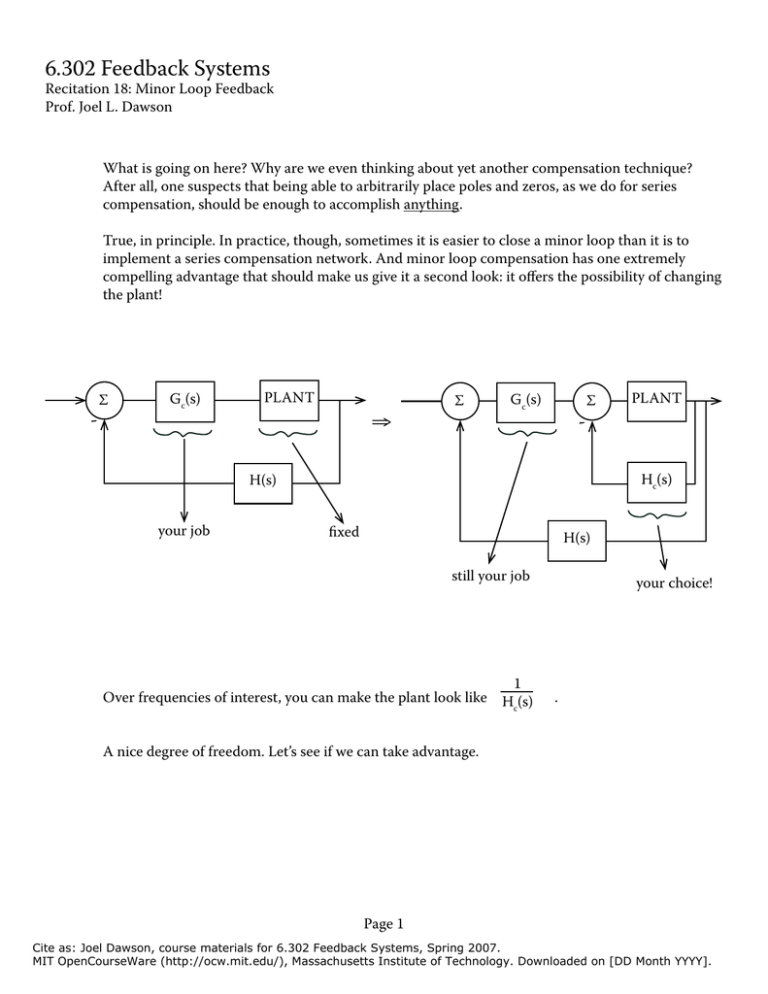6.302 Feedback Systems
advertisement

6.302 Feedback Systems Recitation 8: Minor Loop Feedback Prof. Joel L. Dawson What is going on here? Why are we even thinking about yet another compensation technique? After all, one suspects that being able to arbitrarily place poles and zeros, as we do for series compensation, should be enough to accomplish anything. True, in principle. In practice, though, sometimes it is easier to close a minor loop than it is to implement a series compensation network. And minor loop compensation has one extremely compelling advantage that should make us give it a second look: it offers the possibility of changing the plant! - Σ Gc(s) PLANT ⇒ Σ Gc(s) - Σ Hc(s) H(s) your job PLANT fixed H(s) still your job Over frequencies of interest, you can make the plant look like H (s) c your choice! . A nice degree of freedom. Let’s see if we can take advantage. Page Cite as: Joel Dawson, course materials for 6.302 Feedback Systems, Spring 2007. MIT OpenCourseWare (http://ocw.mit.edu/), Massachusetts Institute of Technology. Downloaded on [DD Month YYYY]. 6.302 Feedback Systems Recitation 8: Minor Loop Feedback Prof. Joel L. Dawson CLASS EXERCISE: “Why minor loop compensation might help.” Consider the following feedback system. X(s) - k 0 s + “PLANT” 03 s Gc(s) Σ Y(s) -4 The problem is that k can range anywhere from 0 to 02! Calculate the phase margin and loop crossover frequency at the two extremes. So we see here that variation in the plant makes things hard. To account for the variation, we wind up needing to choose Gc(s) such that we get a sufficiently low crossover frequency. But what do we have that naturally supresses variation? Feedback, of course! Consider the following minor loop, and the corresponding change in Gc(s): X(s) + Σ + 04 s - - k 0-4s + Σ Y(s) If we approximate + k as just k, our system now looks like X(s) - Σ 04 s 0 k -4 s+ Y(s) Page 2 Cite as: Joel Dawson, course materials for 6.302 Feedback Systems, Spring 2007. MIT OpenCourseWare (http://ocw.mit.edu/), Massachusetts Institute of Technology. Downloaded on [DD Month YYYY]. 6.302 Feedback Systems Recitation 8: Minor Loop Feedback Prof. Joel L. Dawson Now let’s compute phase margins and ωc’s 06 05 04 03 ωc=04 for both ks 02 0 00 0- - 00 0 02 03 04 05 06 0-2 -2 -2 k=00 k=0 ωc= 04, φm = 90˚ for both cases! Minor loop feedback gave us what feedback always gives us: it calmed down variations in the forward path. Often in circuits, minor loop feedback is the easiest thing to do. Consider the problem of trying to stabalize the following system: R R vi R + vo + + R Let’s say that the open-loop transfer function of each op-amp is A0 a(s) = τs + → L(s) = - 2 A - τs +0 3 Page 3 Cite as: Joel Dawson, course materials for 6.302 Feedback Systems, Spring 2007. MIT OpenCourseWare (http://ocw.mit.edu/), Massachusetts Institute of Technology. Downloaded on [DD Month YYYY]. 6.302 Feedback Systems Recitation 8: Minor Loop Feedback Prof. Joel L. Dawson You could try to compensate this thing using series compensation...say dominant pole: R + R + C R + vo R L(s) = - 2 RCs + A - τs +0 3 Some numbers would help clarify the issue here. Let A0 = 06, and let τ = 0˚. If we ask that we crossover at least a decade before the trio of poles @ rps, then we require: ωC = 0- rps → 2 A03 RCωC RC = 2 = A03 0- = 9 8 2 · 0 = 5 × 0 sec That is an enormous time constant! If we chose R = 0 MΩ, we would still need C = 5 × 0F. Even a capacitor of F is too big to imagine. Fortunately, minor loop compensation comes to the rescue... Page 4 Cite as: Joel Dawson, course materials for 6.302 Feedback Systems, Spring 2007. MIT OpenCourseWare (http://ocw.mit.edu/), Massachusetts Institute of Technology. Downloaded on [DD Month YYYY]. 6.302 Feedback Systems Recitation 8: Minor Loop Feedback Prof. Joel L. Dawson R R C R + R + R + R L(s) = -(-)(- RCs )(-) = RCs Nice. One more thing to know about minor loop feedback. Remember that in the last recitation, we talked about a graphical interpretation of Black’s Formula: + - G(s) Σ H(s) log0| . | G(s) - H(s) -2 ωc ω The trick for graphing the closed-loop response for the system was to overlay G(s) and H(s) , and then Page 5 Cite as: Joel Dawson, course materials for 6.302 Feedback Systems, Spring 2007. MIT OpenCourseWare (http://ocw.mit.edu/), Massachusetts Institute of Technology. Downloaded on [DD Month YYYY]. 6.302 Feedback Systems Recitation 8: Minor Loop Feedback Prof. Joel L. Dawson Trace out the lower of the two curves at all frequencies. We can apply a similar trick to determine the forward path of the major loop of a minor loop compensated system. Σ - G(s) - Σ G2(s) H(s) H2(s) To obtain the forward path of the major loop, we just overlay plots of G(s)G2(s) and G(s). The forward path is the lower of the two curves at all frequencies. log0| . | ․ H(s) G(s) H(s) G(s)G2(s) major l for war oop d path Page 6 Cite as: Joel Dawson, course materials for 6.302 Feedback Systems, Spring 2007. MIT OpenCourseWare (http://ocw.mit.edu/), Massachusetts Institute of Technology. Downloaded on [DD Month YYYY].





